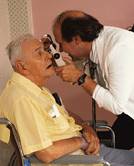Eye Surgery Errors Rare But Serious
Incidents included the wrong eye being operated on, or the wrong transplant, study found.
|
E-mail this article
Subscribe to news
Printer friendly version
|

(SOURCE: JAMA/Archives journals, news release, Nov. 12, 2007)
TUESDAY, Nov. 13 (HealthDay News) -- Errors are rare but troublesome in eye surgery, say U.S. researchers who analyzed 106 cases of surgical confusions that included operating on the wrong patient, the wrong site or using wrong procedure.
The study authors, from the Lions Eye Institute at Albany Medical College in New York found:
- The most common type of surgical confusion was wrong lens implants, which occurred in 67 of the 106 cases (63 percent). In most cases, this occurred because lens specifications weren't properly checked before implantation.
- In 14 cases (13 percent),the wrong eye was injected with anesthesia. The wrong eye was operated on in 15 cases (14 percent).
- Confusions involving the wrong patient or wrong procedure occurred in eight cases.
- The wrong tissue was transplanted in two cases.
- Confusions involving the wrong implant or transplant caused more severe injuries than confusions involving the wrong eye, patient or procedure.
- The use of Universal Protocol -- which includes consistent preoperative verification, site marking and a time-out immediately before incision -- would have prevented 85 percent of the 106 surgical confusions in this study.
The rate of these incidents remains very low-- the researchers estimated that about 69 surgical confusions occur for every one million eye operations.
The findings were published in the November issue of the journal Archives of Ophthalmology.
"The causes of these confusions were faulty systems, processes and conditions that led people to make mistakes, more often than an individual's recklessness," the team wrote.
More information
The U.S. Agency for Healthcare Research and Quality offers surgery safety tips for patients.
Copyright © 2007 ScoutNews, LLC. All rights reserved. 
HealthDayNews articles are derived from various sources and do not reflect federal policy. healthfinder.gov does not endorse opinions, products, or services that may appear in news stories. For more information on health topics in the news, visit the healthfinder.gov health library.